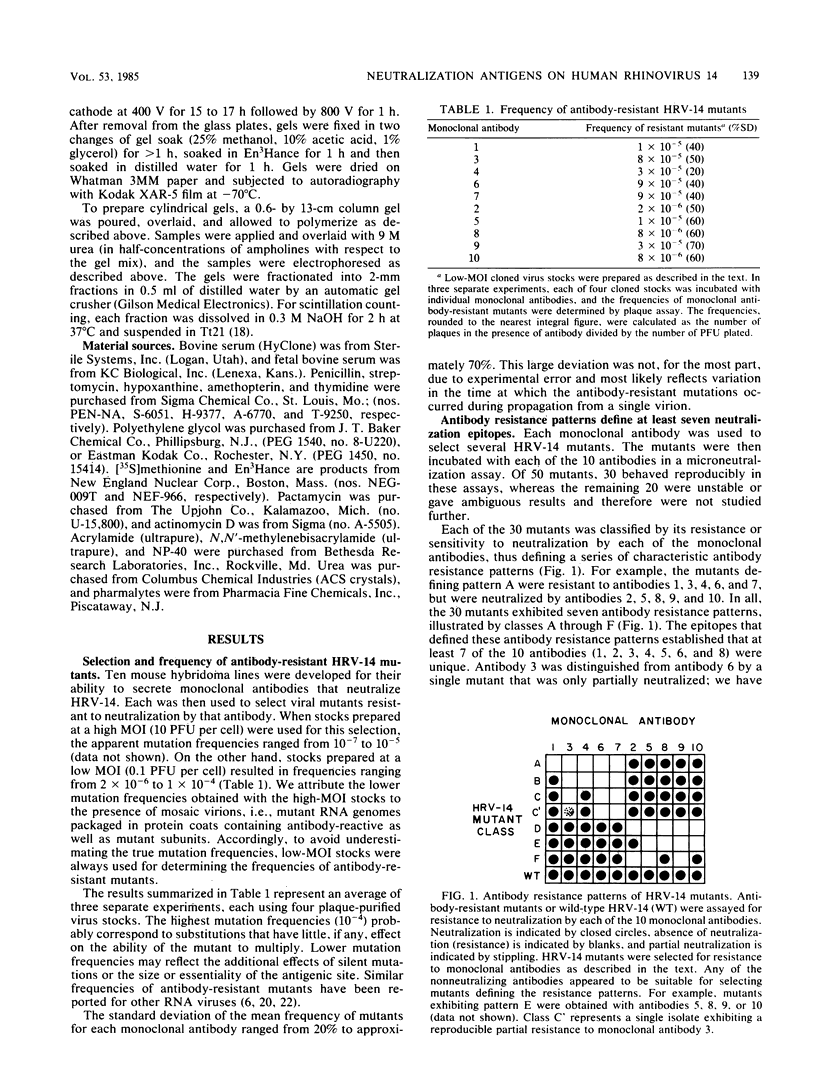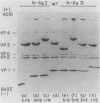Abstract
A collection of 28 mutants of human rhinovirus 14, selected for resistance to 10 individual neutralizing monoclonal antibodies, was used to identify two major neutralization antigens, N-Ag I and N-Ag II. Isoelectric analysis showed that all 16 of the N-Ag I mutants analyzed were charge altered in VP1;8 of 12 N-Ag II mutants were altered in VP3. These results suggest that N-Ag I resides on VP1, whereas N-Ag II lies on VP3. The frequency of charge alterations was much higher than predicted by the genetic code, suggesting that charged amino acids on the antigenic sites play an important role in interaction with neutralizing antibody. Antibodies against N-Ag I and N-Ag II neutralize with widely different efficiencies.
Full text
PDF






Images in this article
Selected References
These references are in PubMed. This may not be the complete list of references from this article.
- Arnold E., Erickson J. W., Fout G. S., Frankenberger E. A., Hecht H. J., Luo M., Rossman M. G., Rueckert R. R. Virion orientation in cubic crystals of the human common cold virus HRV14. J Mol Biol. 1984 Aug 15;177(3):417–430. doi: 10.1016/0022-2836(84)90293-6. [DOI] [PubMed] [Google Scholar]
- Brioen P., Dekegel D., Boeyé A. Neutralization of poliovirus by antibody-mediated polymerization. Virology. 1983 Jun;127(2):463–468. doi: 10.1016/0042-6822(83)90159-9. [DOI] [PubMed] [Google Scholar]
- Brown F. Neutralizing site of poliovirus. Nature. 1983 Aug 4;304(5925):395–396. doi: 10.1038/304395a0. [DOI] [PubMed] [Google Scholar]
- Dernick R., Heukeshoven J., Hilbrig M. Induction of neutralizing antibodies by all three structural poliovirus polypeptides. Virology. 1983 Oct 15;130(1):243–246. doi: 10.1016/0042-6822(83)90134-4. [DOI] [PubMed] [Google Scholar]
- Emini E. A., Jameson B. A., Wimmer E. Priming for and induction of anti-poliovirus neutralizing antibodies by synthetic peptides. Nature. 1983 Aug 25;304(5928):699–703. doi: 10.1038/304699a0. [DOI] [PubMed] [Google Scholar]
- Emini E. A., Kao S. Y., Lewis A. J., Crainic R., Wimmer E. Functional basis of poliovirus neutralization determined with monospecific neutralizing antibodies. J Virol. 1983 May;46(2):466–474. doi: 10.1128/jvi.46.2.466-474.1983. [DOI] [PMC free article] [PubMed] [Google Scholar]
- Emini E. A., Ostapchuk P., Wimmer E. Bivalent attachment of antibody onto poliovirus leads to conformational alteration and neutralization. J Virol. 1983 Nov;48(2):547–550. doi: 10.1128/jvi.48.2.547-550.1983. [DOI] [PMC free article] [PubMed] [Google Scholar]
- Erickson J. W., Frankenberger E. A., Rossmann M. G., Fout G. S., Medappa K. C., Rueckert R. R. Crystallization of a common cold virus, human rhinovirus 14: "isomorphism" with poliovirus crystals. Proc Natl Acad Sci U S A. 1983 Feb;80(4):931–934. doi: 10.1073/pnas.80.4.931. [DOI] [PMC free article] [PubMed] [Google Scholar]
- Evans D. M., Minor P. D., Schild G. S., Almond J. W. Critical role of an eight-amino acid sequence of VP1 in neutralization of poliovirus type 3. Nature. 1983 Aug 4;304(5925):459–462. doi: 10.1038/304459a0. [DOI] [PubMed] [Google Scholar]
- Halfpap L. M., Cooney M. K. Isolation of rhinovirus intertypes related to either rhinoviruses 12 and 78 or 36 and 58. Infect Immun. 1983 Apr;40(1):213–218. doi: 10.1128/iai.40.1.213-218.1983. [DOI] [PMC free article] [PubMed] [Google Scholar]
- Hogle J. M. Preliminary studies of crystals of poliovirus type I. J Mol Biol. 1982 Oct 5;160(4):663–668. doi: 10.1016/0022-2836(82)90322-9. [DOI] [PubMed] [Google Scholar]
- Icenogle J., Shiwen H., Duke G., Gilbert S., Rueckert R., Anderegg J. Neutralization of poliovirus by a monoclonal antibody: kinetics and stoichiometry. Virology. 1983 Jun;127(2):412–425. doi: 10.1016/0042-6822(83)90154-x. [DOI] [PubMed] [Google Scholar]
- King A. M., Newman J. W. Temperature-sensitive mutants of foot-and-mouth disease virus with altered structural polypeptides. I. Identification by electrofocusing. J Virol. 1980 Apr;34(1):59–66. doi: 10.1128/jvi.34.1.59-66.1980. [DOI] [PMC free article] [PubMed] [Google Scholar]
- Köhler G., Milstein C. Continuous cultures of fused cells secreting antibody of predefined specificity. Nature. 1975 Aug 7;256(5517):495–497. doi: 10.1038/256495a0. [DOI] [PubMed] [Google Scholar]
- Mandel B. Neutralization of poliovirus: a hypothesis to explain the mechanism and the one-hit character of the neutralization reaction. Virology. 1976 Feb;69(2):500–510. doi: 10.1016/0042-6822(76)90480-3. [DOI] [PubMed] [Google Scholar]
- Mapoles J. E., Anderegg J. W., Rueckert R. R. Properties of poliovirus propagated in medium containing cesium chloride: implications for picornaviral structure. Virology. 1978 Oct 1;90(1):103–111. doi: 10.1016/0042-6822(78)90337-9. [DOI] [PubMed] [Google Scholar]
- Medappa K. C., McLean C., Rueckert R. R. On the structure of rhinovirus 1A. Virology. 1971 May;44(2):259–270. doi: 10.1016/0042-6822(71)90258-3. [DOI] [PubMed] [Google Scholar]
- Minor P. D., Schild G. C., Bootman J., Evans D. M., Ferguson M., Reeve P., Spitz M., Stanway G., Cann A. J., Hauptmann R. Location and primary structure of a major antigenic site for poliovirus neutralization. Nature. 1983 Feb 24;301(5902):674–679. doi: 10.1038/301674a0. [DOI] [PubMed] [Google Scholar]
- O'Farrell P. H. High resolution two-dimensional electrophoresis of proteins. J Biol Chem. 1975 May 25;250(10):4007–4021. [PMC free article] [PubMed] [Google Scholar]
- Portner A., Webster R. G., Bean W. J. Similar frequencies of antigenic variants in Sendai, vesicular stomatitis, and influenza A viruses. Virology. 1980 Jul 15;104(1):235–238. doi: 10.1016/0042-6822(80)90382-7. [DOI] [PubMed] [Google Scholar]
- Rueckert R. R., Pallansch M. A. Preparation and characterization of encephalomyocarditis (EMC) virus. Methods Enzymol. 1981;78(Pt A):315–325. [PubMed] [Google Scholar]
- Rueckert R. R., Wimmer E. Systematic nomenclature of picornavirus proteins. J Virol. 1984 Jun;50(3):957–959. doi: 10.1128/jvi.50.3.957-959.1984. [DOI] [PMC free article] [PubMed] [Google Scholar]
- Vrijsen R., Rombaut B., Boeye A. pH-dependent aggregation and electrofocusing of poliovirus. J Gen Virol. 1983 Oct;64(Pt 10):2339–2342. doi: 10.1099/0022-1317-64-10-2339. [DOI] [PubMed] [Google Scholar]
- Wallis C., Melnick J. L. Virus aggregation as the cause of the non-neutralizable persistent fraction. J Virol. 1967 Jun;1(3):478–488. doi: 10.1128/jvi.1.3.478-488.1967. [DOI] [PMC free article] [PubMed] [Google Scholar]
- Wimmer E., Jameson B. A., Emini E. A. Poliovirus antigenic sites and vaccines. Nature. 1984 Mar 1;308(5954):19–19. doi: 10.1038/308019a0. [DOI] [PubMed] [Google Scholar]



